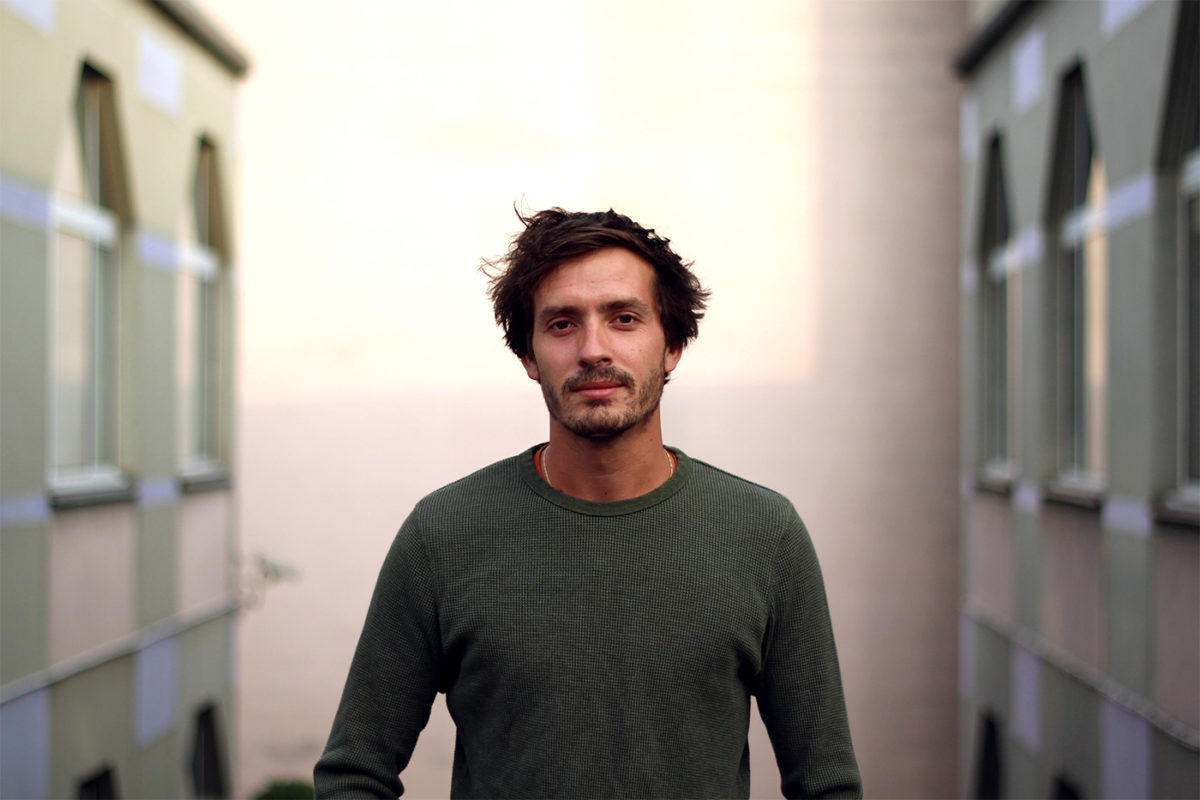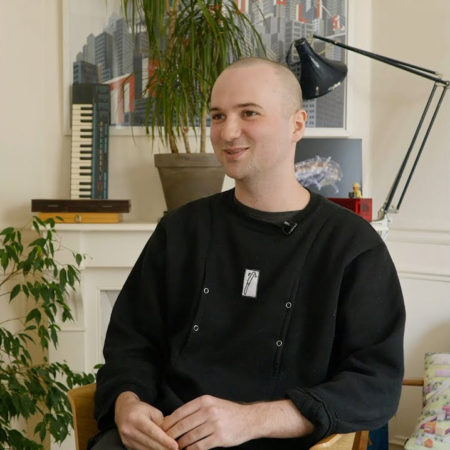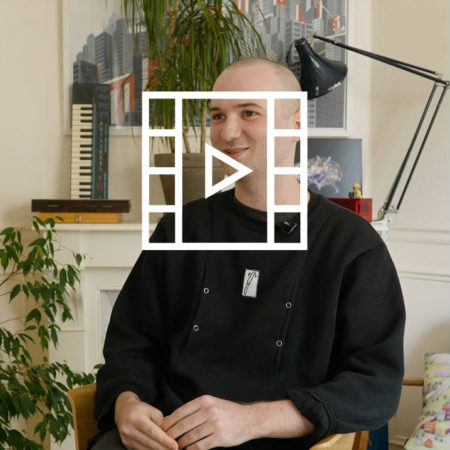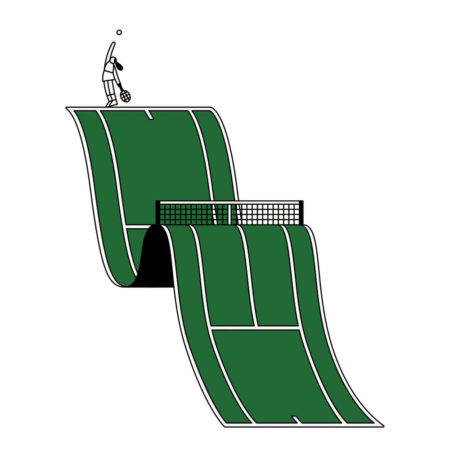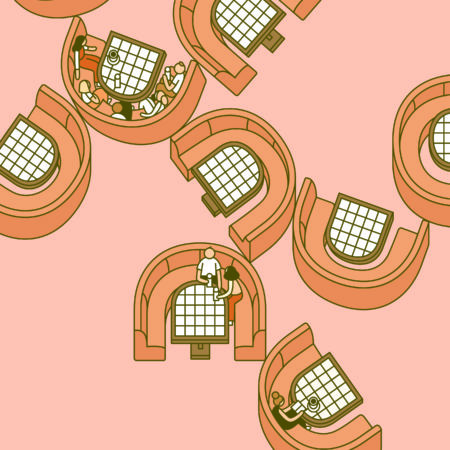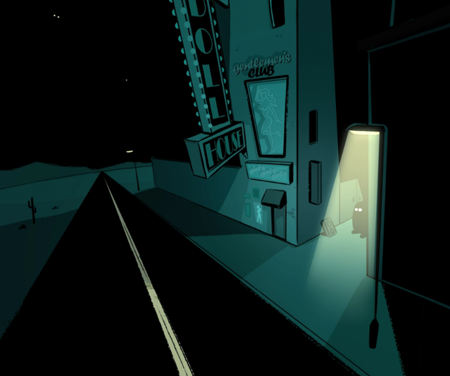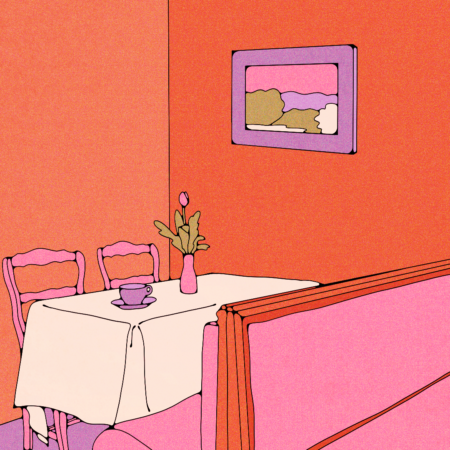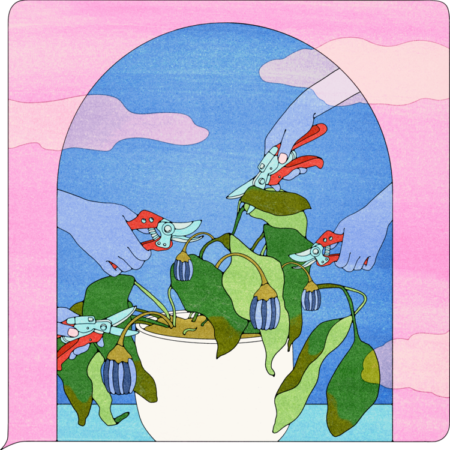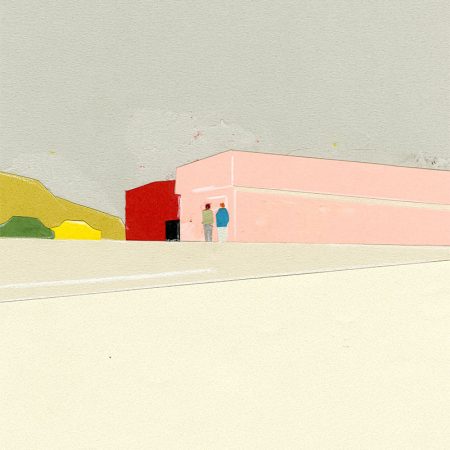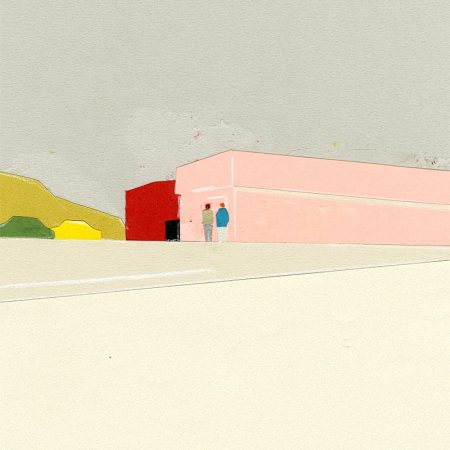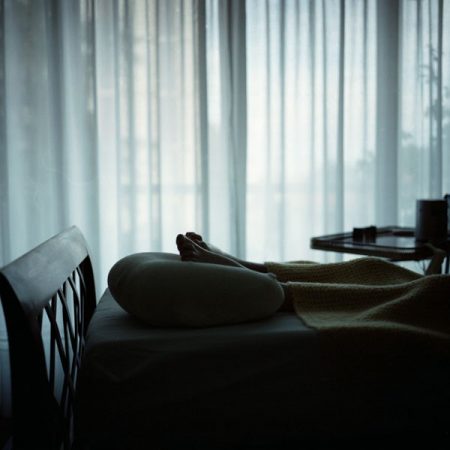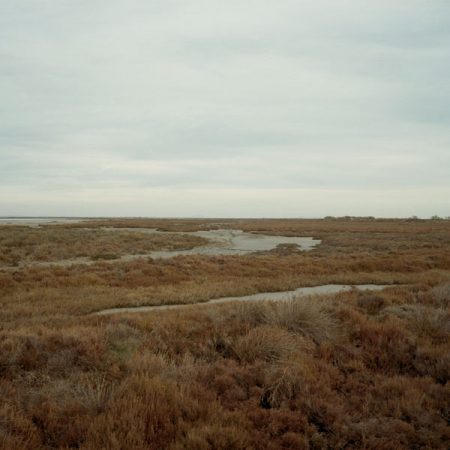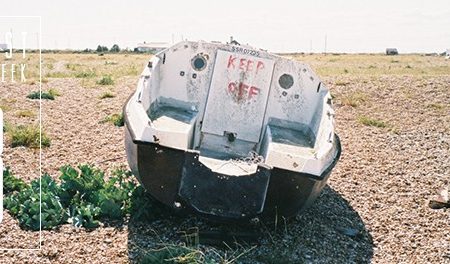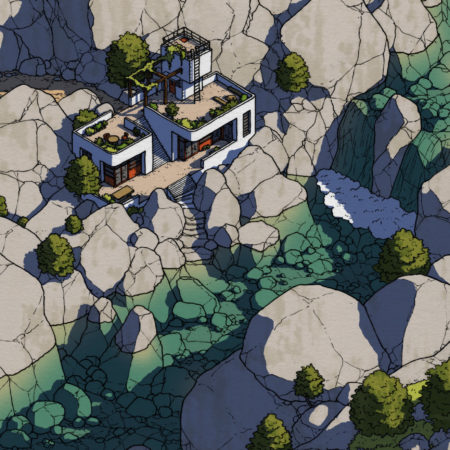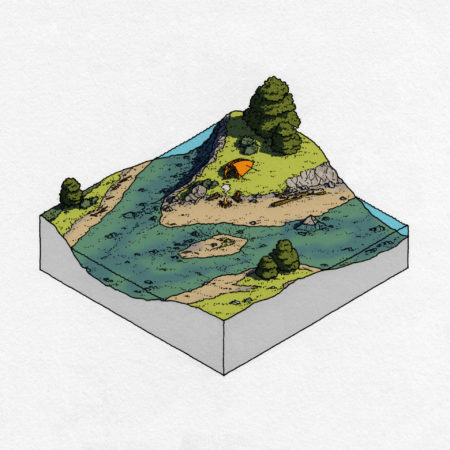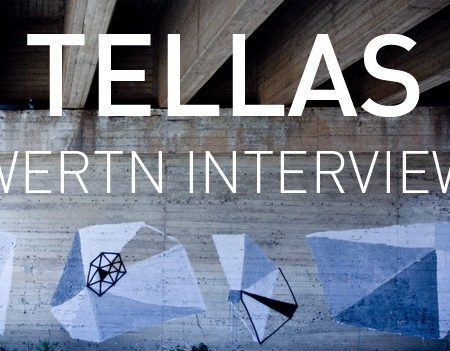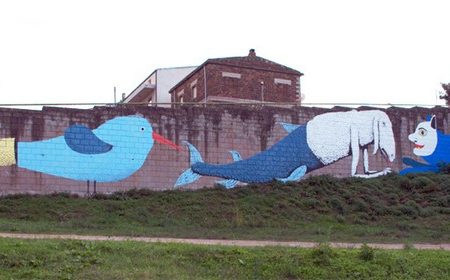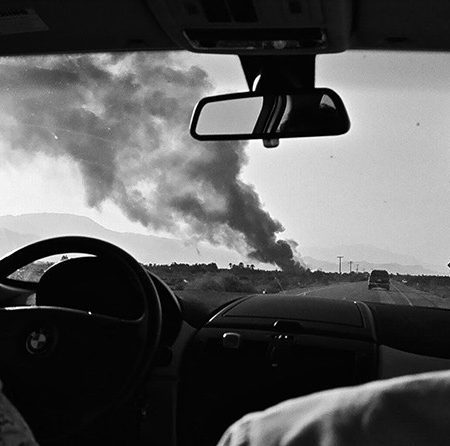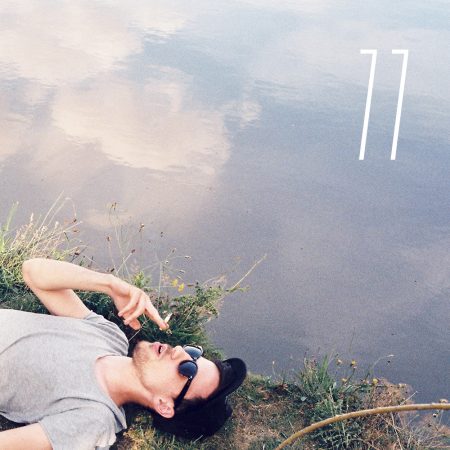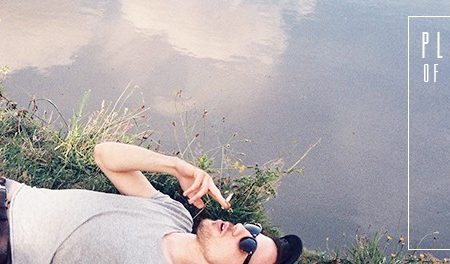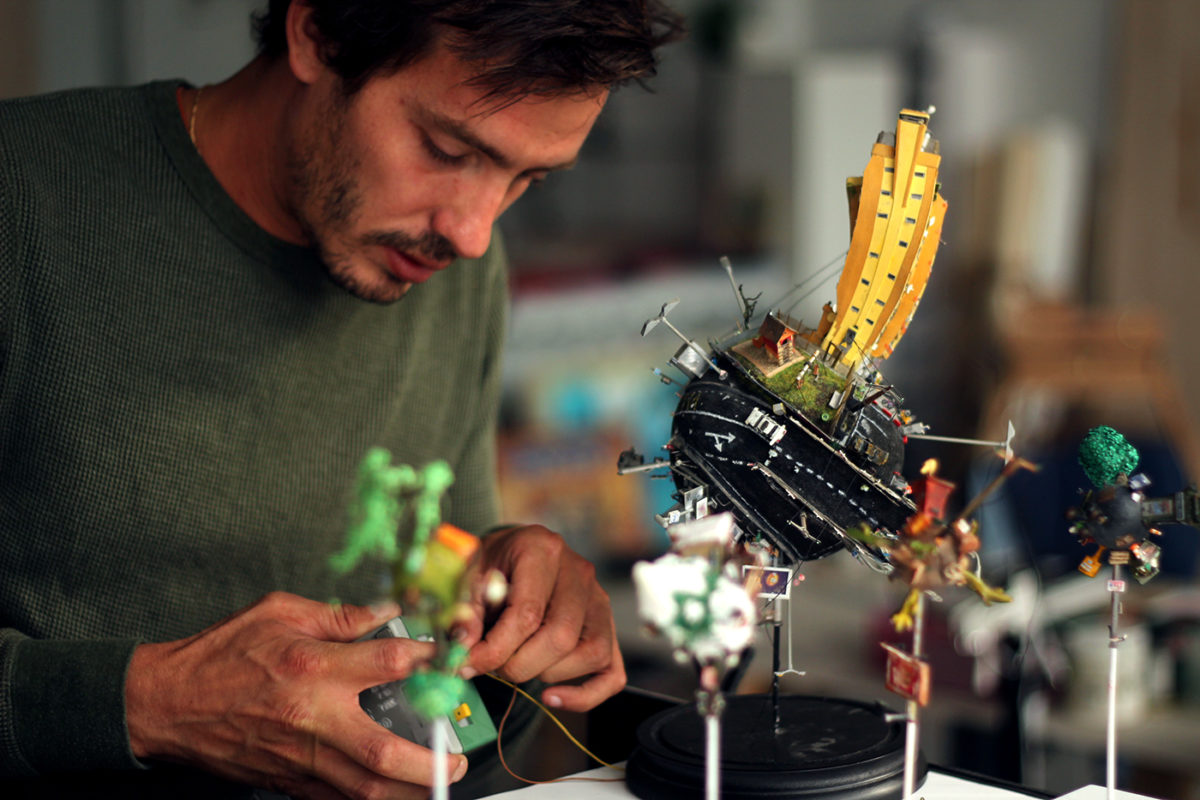
If I send you to my microscopic world, you would be around 8mm tall!
Tristan Blondeau
ART . October 8th, 2020Tristan Blondeau is a french artist crafting real miniature worlds and animating them.
We met in his studio in Paris in early September 2020.
What can we find in your head Tristan?
I got the feeling that I’m starting a psychotherapy ahah.. There are so many questions in my head so it makes it difficult to answer. I would simply say the main guideline that resonate in my head is to make the things I love in an authentic, original and sincere way with the ones I love and the longer I can. I’m sure you will learn along the reading of this interview what else is roaming around in my head, have a nice trip.
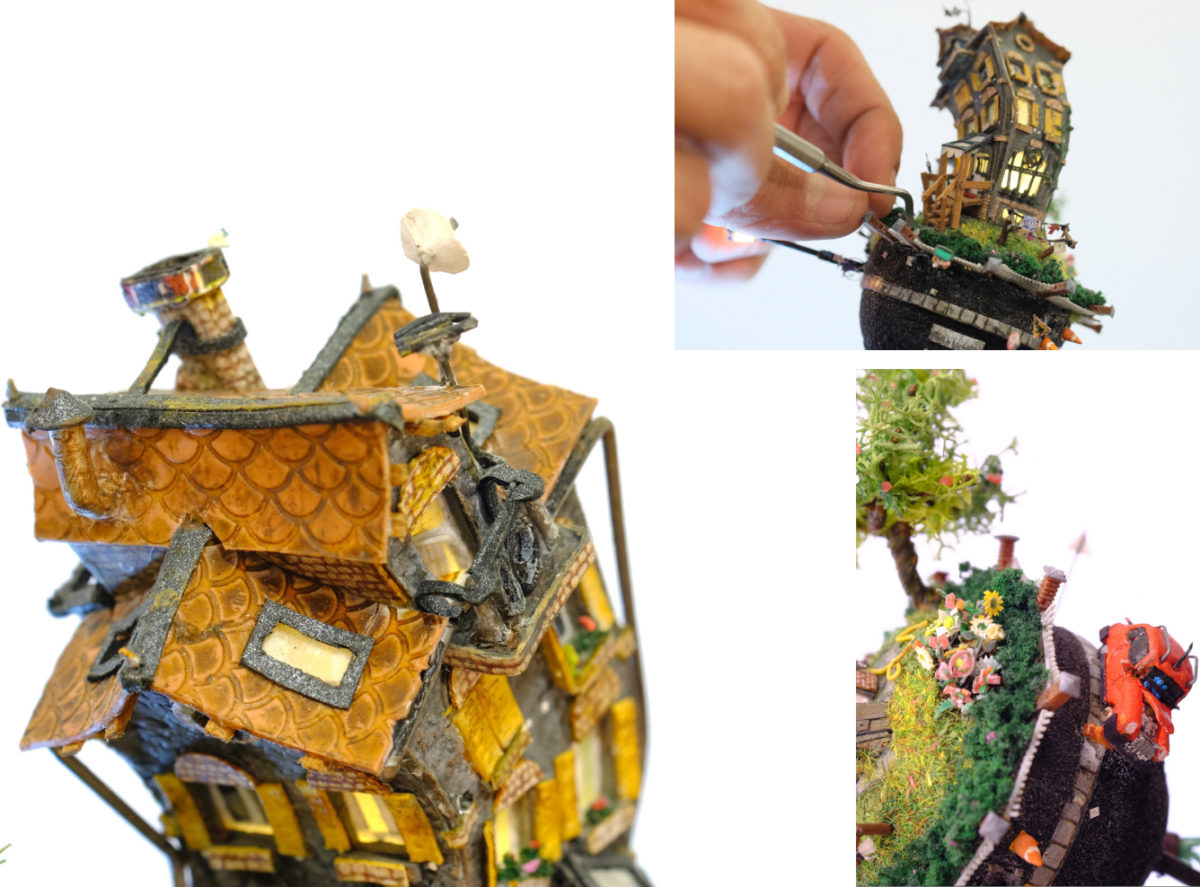
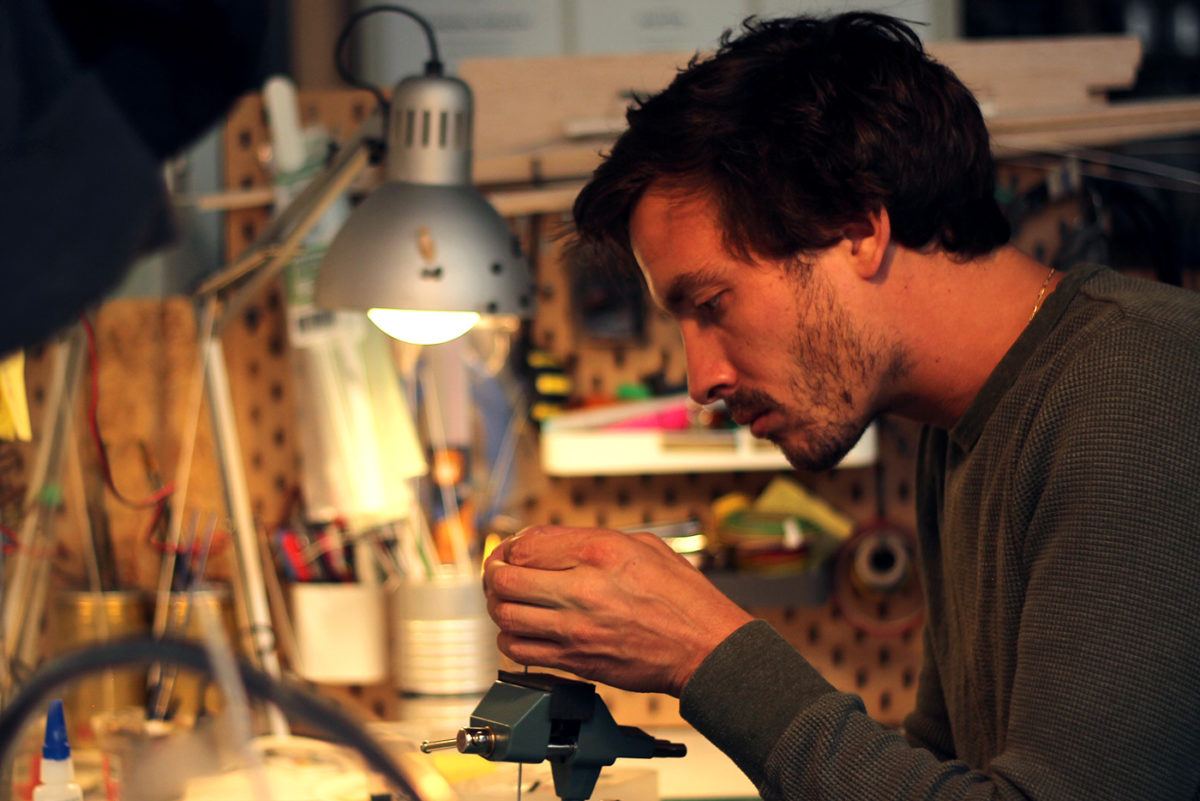
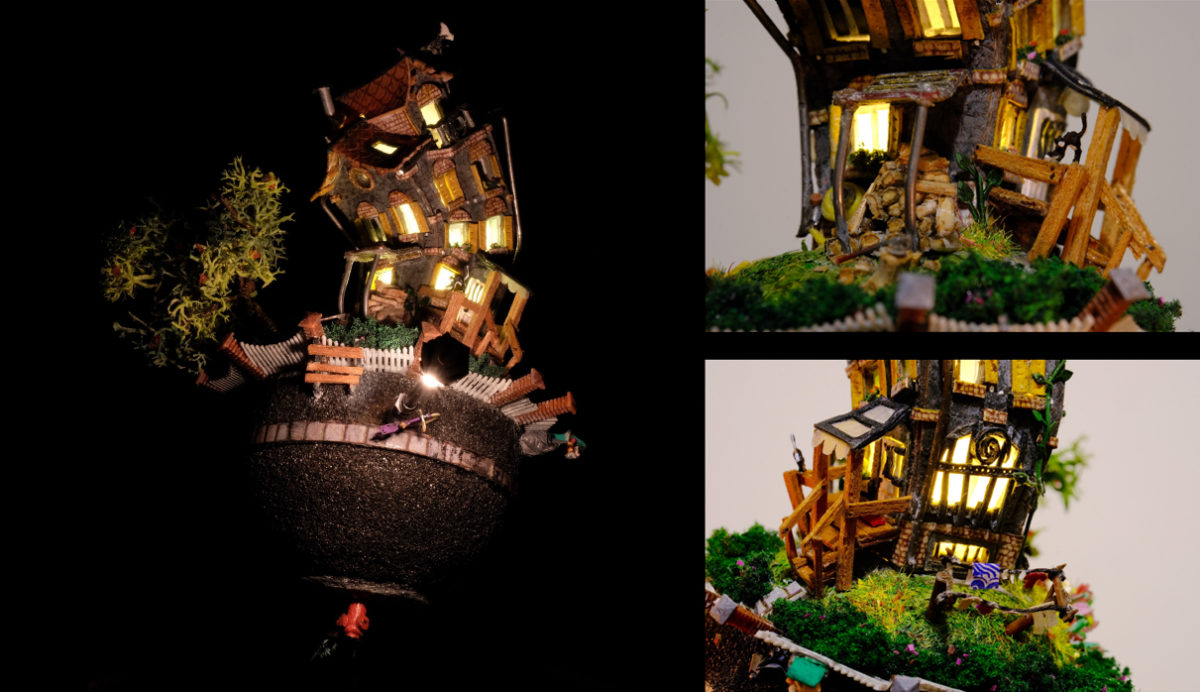
Can you introduce yourself and these little worlds you’re creating?
My name is Tristan Blondeau, 30 years old, born and raised in he eastern suburbs of Paris. I am living in Paris for 7 years now. I went to a culinary school with pastry specialisation and then worked in luxury hotels as a pastry chef for 8 years. But today I prefer to eat cakes rather than make them. So I stopped my pastry job last year to devote my self completely to model making, miniature art and stop motion, things I always have practiced beside my work.
My little worlds are usually characterized by architectures with crazy and twisted perspectives. Sometimes on a planet, in a tree, on a bug or on a human body part, it’s often about human environment even if you never really see humans in my work.
How did you get into model making?
First, as long as I can remember, I have always been fascinated by tiny stuff and microscopic worlds. When I was kid, the tinnier my toy was, the more I liked it. I can spend hours, still today, watching the most common insect living his life. I remember myself, at around 8, destroying my car toys meticulously to make car chase accident scenes that I shot with my father film camera. I never made airplane models, railway models, Warhammer or things like that when I was younger, as many people ask me.
I already had the love of tiny stuff but the passion of model making came later. Before going in culinary school I did one year in an art school. During an architecture class, we had to make the 1:24 scale model of one of the cupboard from the Furniture house by Shigeru Ban (a famous Japanese architect known for the use of card in his constructions). Not a revelation yet, but my first approach of model making. That was one of my favorite workshop I did during that year. I enjoyed a lot working with that grey cardboard, the scalpel, the precision of this kind of exercise… I felt in love with photography the same year.
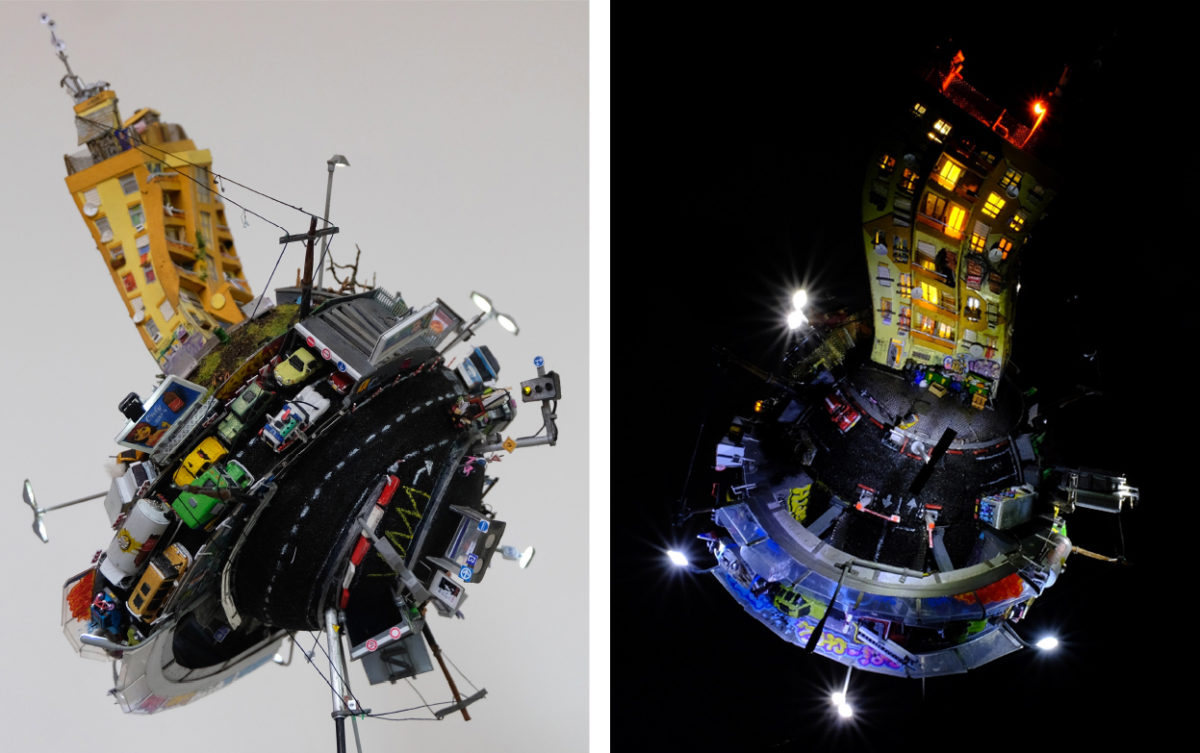
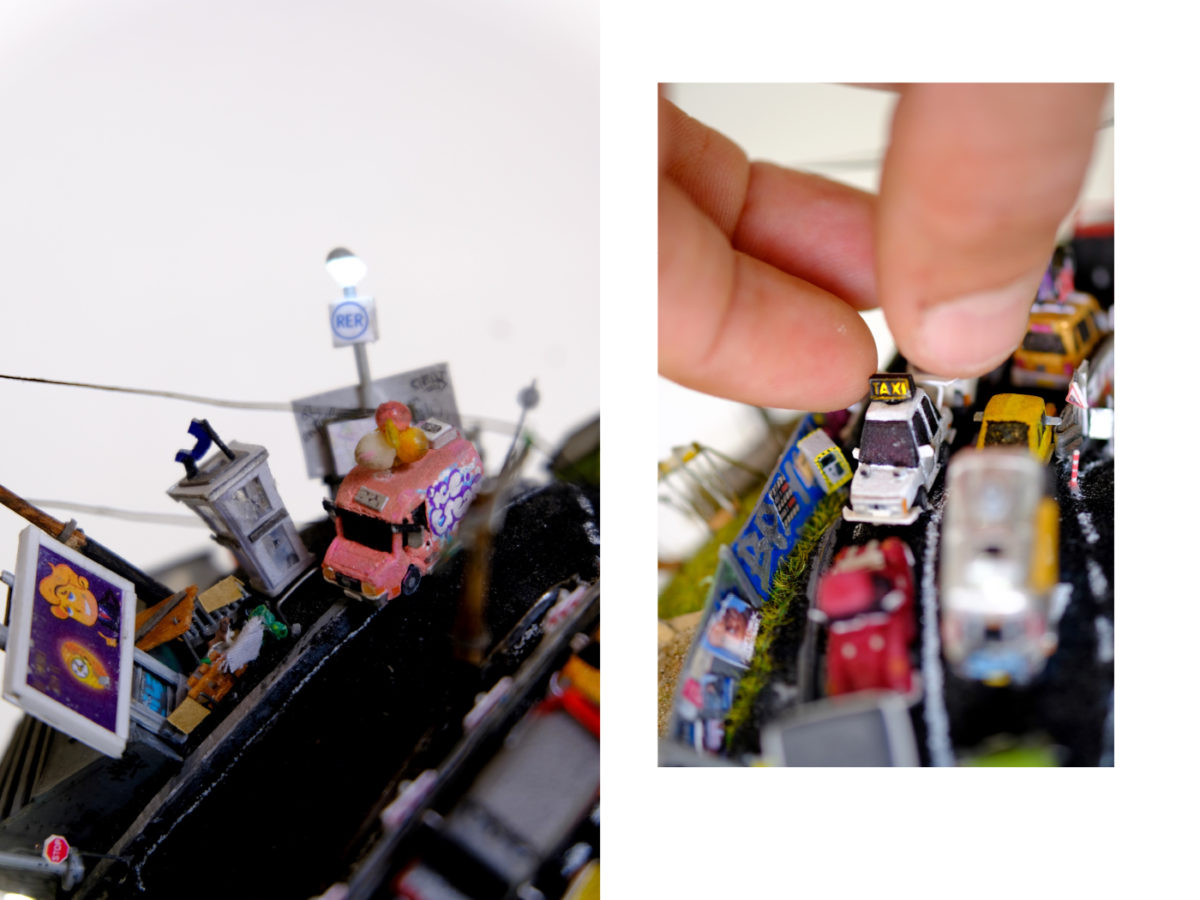
Then, in 2006/07 I started graffiti. A few years after, I had the opportunity to make an exhibition of my « graffiti works » at the « Frigos de Paris ». These are disused cold stores rehabilitated in artists studios. But the problem was that the whole building, outside and inside walls were fully recovered with graffitis. This is the specificity of that place and what it is known for, but exhibit canvas with graffiti paints on a wall full of graffitis, you can imagine how invisible the canvas could have been… So I had to find a solution to make them more visible and the idea came to put some volume. The urban influence that comes out from graffiti naturally directed me towards buildings and trains (the graffiti’s main supports). That was my first real scratch models, then I completely let down canvas for model making.
In 2011, I started exploring lifecasting (process of creating a three-dimensional copy of a living human body). I had a lot of fun melting plaster live casts to build models and I guess that was at this moment that I found my artistic identity and the direction wanted to go in : the curves and shapes I wanted to give to my buildings, the stories I wanted to tell… In 2012, with two of my friends we started to make videos by adding 2D animation on my sculptures. From that time I no longer only designed my models as sculptures but also as a miniature set for animated clips. I can even add that, since then, I have the feeling that a model or a sculpture is over, only when I have done stop motion shots on it and the 2d animation is added. I take as much pleasure shooting my sculptures and miniature sets as I do while I’m creating it. The lighting, the editing, the sound designing are tools that bring so much atmosphere and emotions, I’m exploring those with a lot of pleasure.
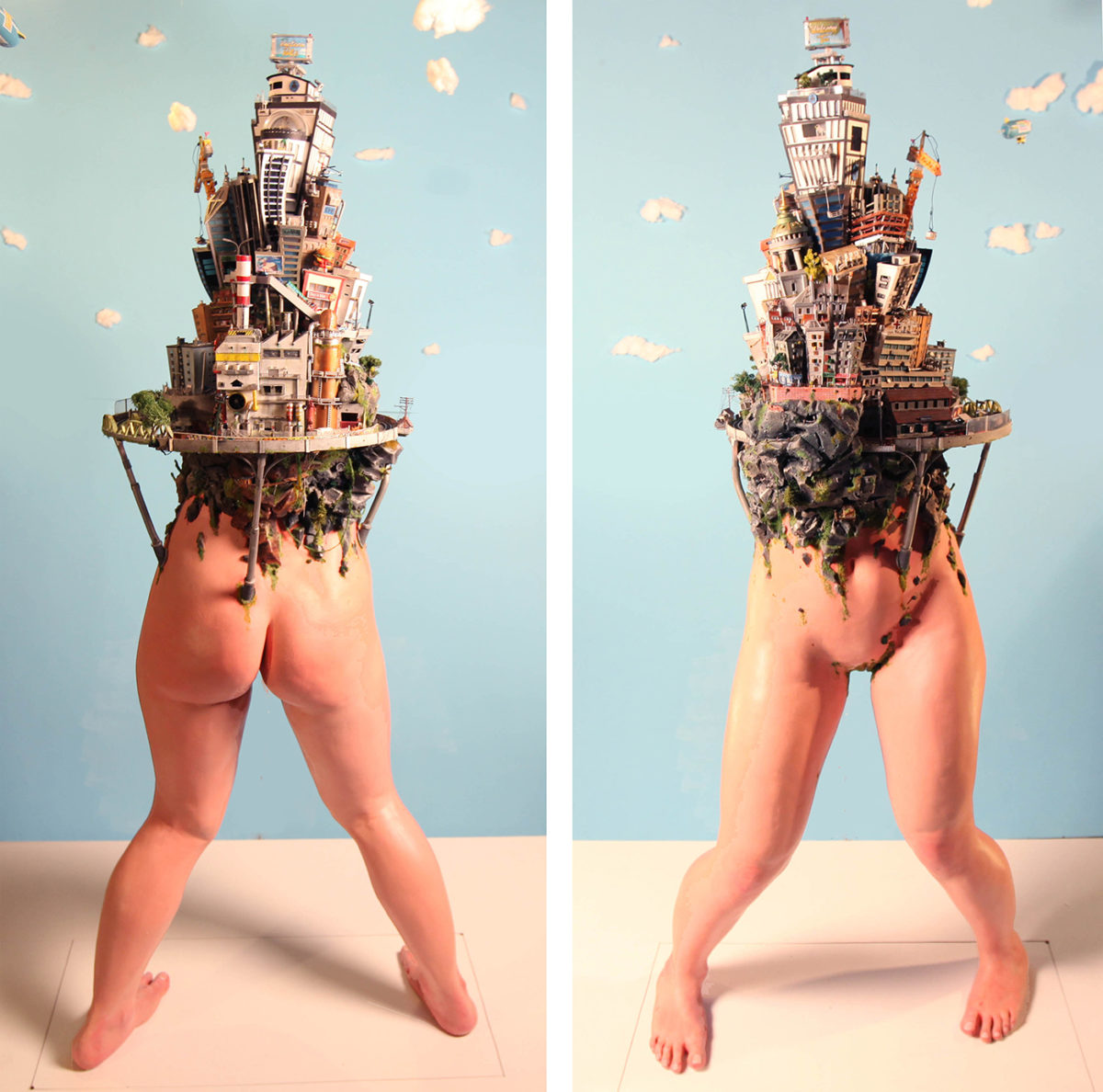
Give us 3 songs we can listen to while exploring your works.
For a big city set by day I’d suggest you a good old hip hop instrumental like Grown Man Sport by Pete Rock. Night Of Roses by Orient Express would be perfect for a country side dusk atmosphere. Birdcage by Youman gives good vibes for a cosmic trip around all my planets.
Tell us about your production process.
I do a first quick sketch with the main shape and elements and a written list of objects I need. Then I do technicals drawings for the measure and, when it’s a complex project, another one for the place and the recording of the electronic stuffs. Some colors and textures tests and off we go! Nothing very artistic in the preliminary researches of my personals projects.
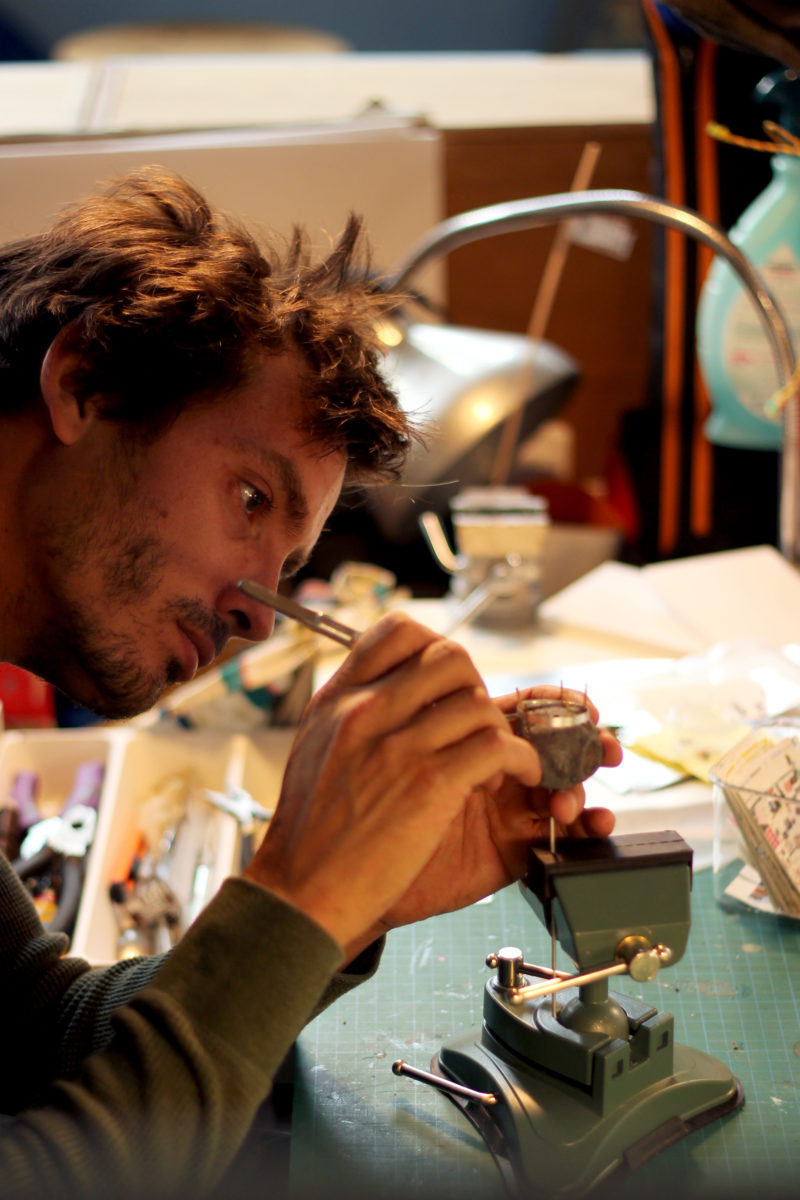
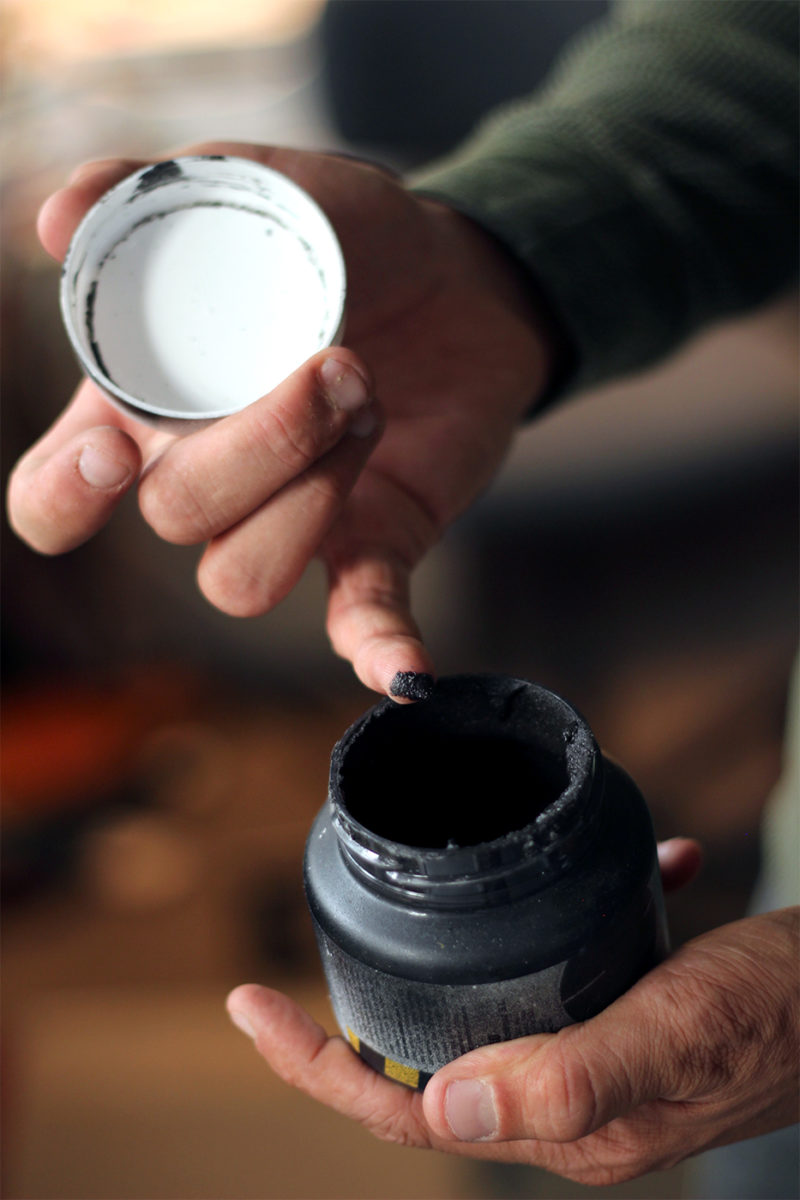
When it’s a commission, I have to give some design research upstream. I’m currently working for the design concept of a mixed media short, combining hand made set, 2D animation, stop motion and live shots. I’m in charge of the Animation Set, so I already provided the director with some colors research for the general concept. Then I did a first functional scale reduce model according to what we have decided together. After checking with him the first model’s draft, we decided to completely change the water render technic and the disposition of the mains elements. For example, thanks to this first model, we decided that water will not be made in live with real water or stop motion with gel, but with 2D animation. For this reason I’m happy to haven’t lost too much time on the preliminary drawings. I did another 1:10 scale model to validate the overall design.
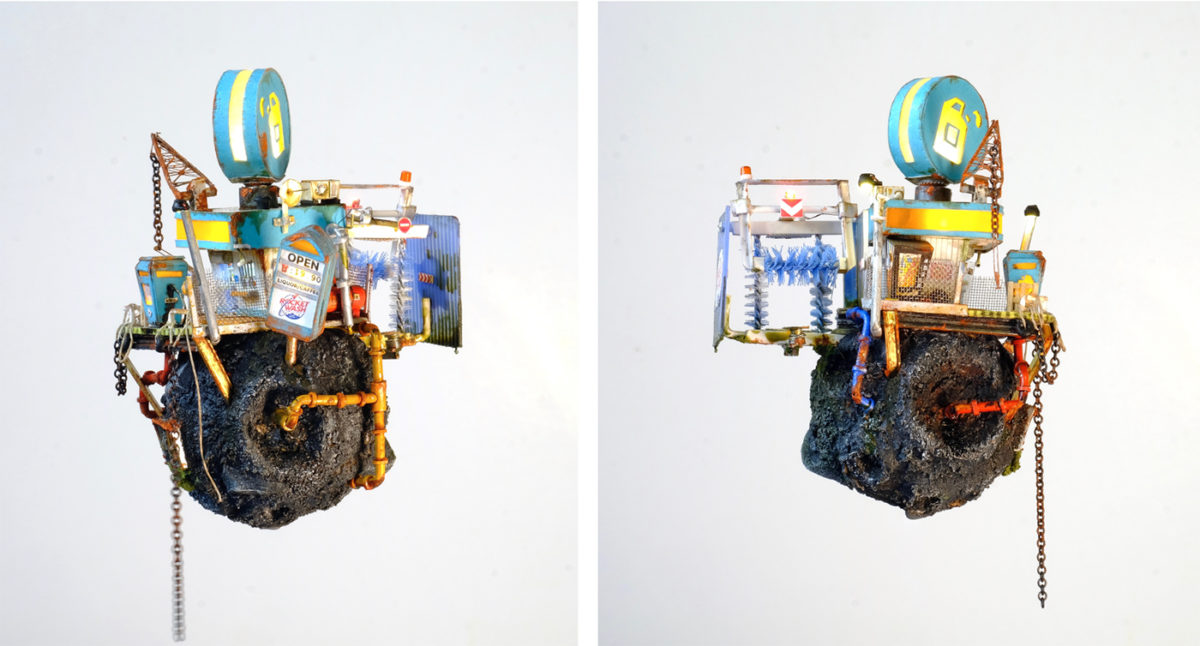
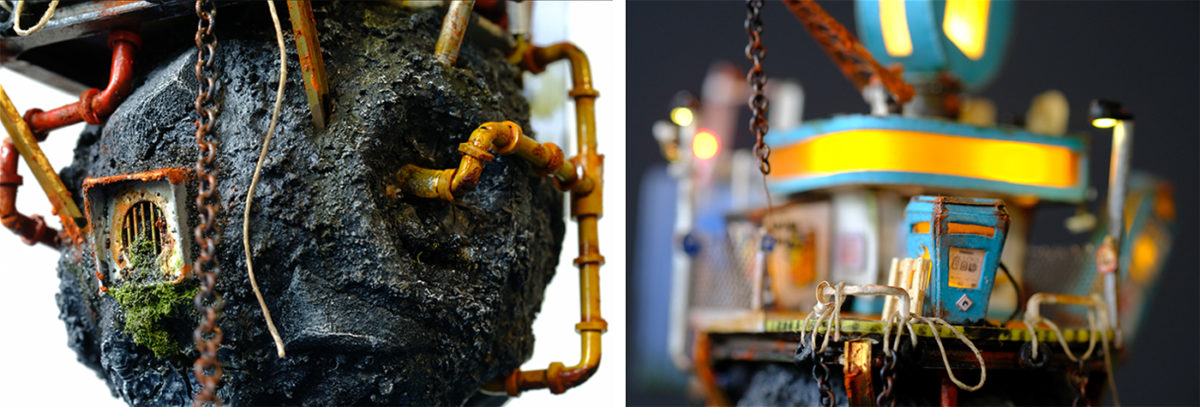
What tools and materials do you use?
My predilection tool are scalpel, tweezers, superglue and airbrush. I use them on card mainly, for the structure of the buildings, houses or big elements. When I say « big » it’s relative because a height floors building can be 13cm height, actually, for me, everything bigger than 2cm is a big element. If I send you to my microscopic world you would be around 8mm tall!
Cellular foam or polystyrene are often big part of the set too. For example the building is made of cardboard, the planet which it is set on, is made of polystyrene. I also use cellular foam for the rocks, cars body, the base of a tree’s foliage that I then recover with texture…
For example for the recipe of the car wash I did on one of my last models, you need : a straw brush cut in three, a styrene a brass rod and a thin steel pipe, two pen’s springs, some grey paper, a 1.5 cm2 piece of blue plastic sheet, a little red LED and of course few drops of super-glue.
I think the fact that I am a self taught model maker can be a strength because I don’t limit myself to the materials I’ve learned working with or those I was told to use. I’m constantly looking for new materials and new ways to use those I already have. I melt scratch building (like an old cap of glue stick) to materials I buy here end there (like wire, card, lights, textured plate …) and I don’t limit my self to a single technic. I used to work with some materials that dioramas makers uses like stabilized lichen or artificial moss but today I’m trying to use it as less as possible for something more graphics and original. Trying to have a subtle balance between cartoons style and realism.
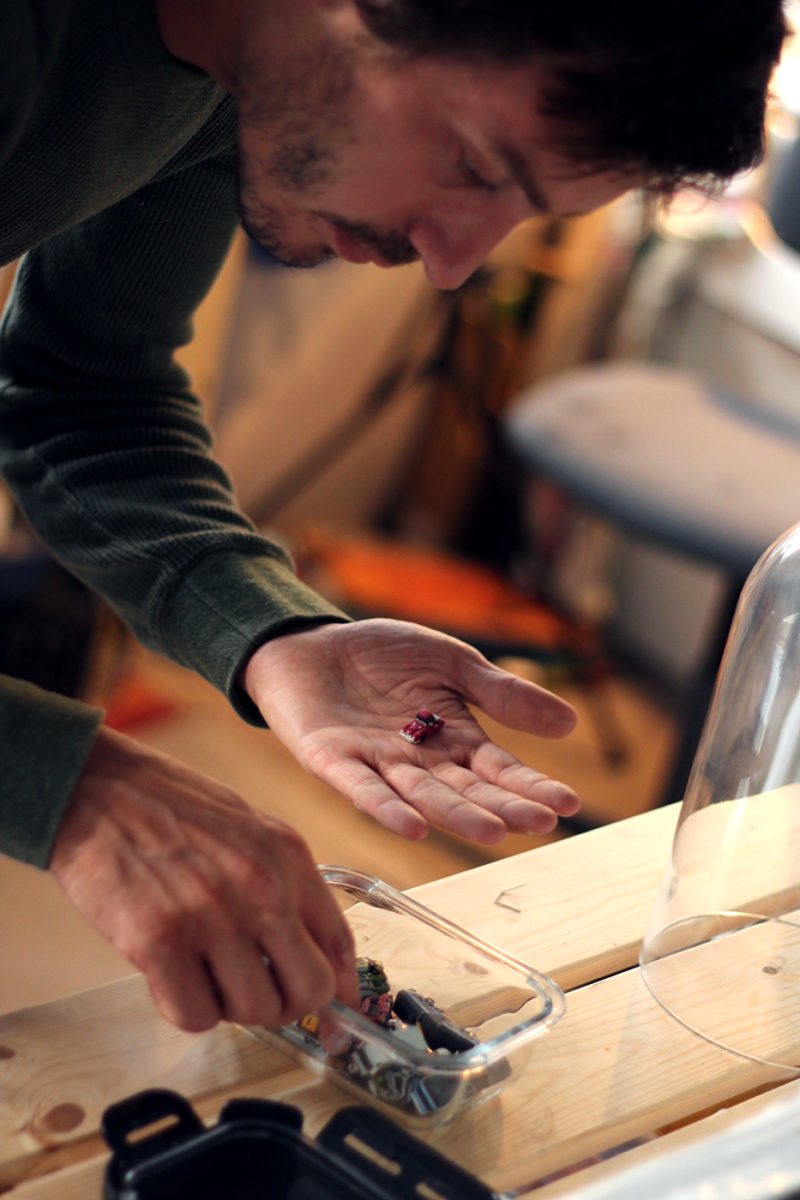
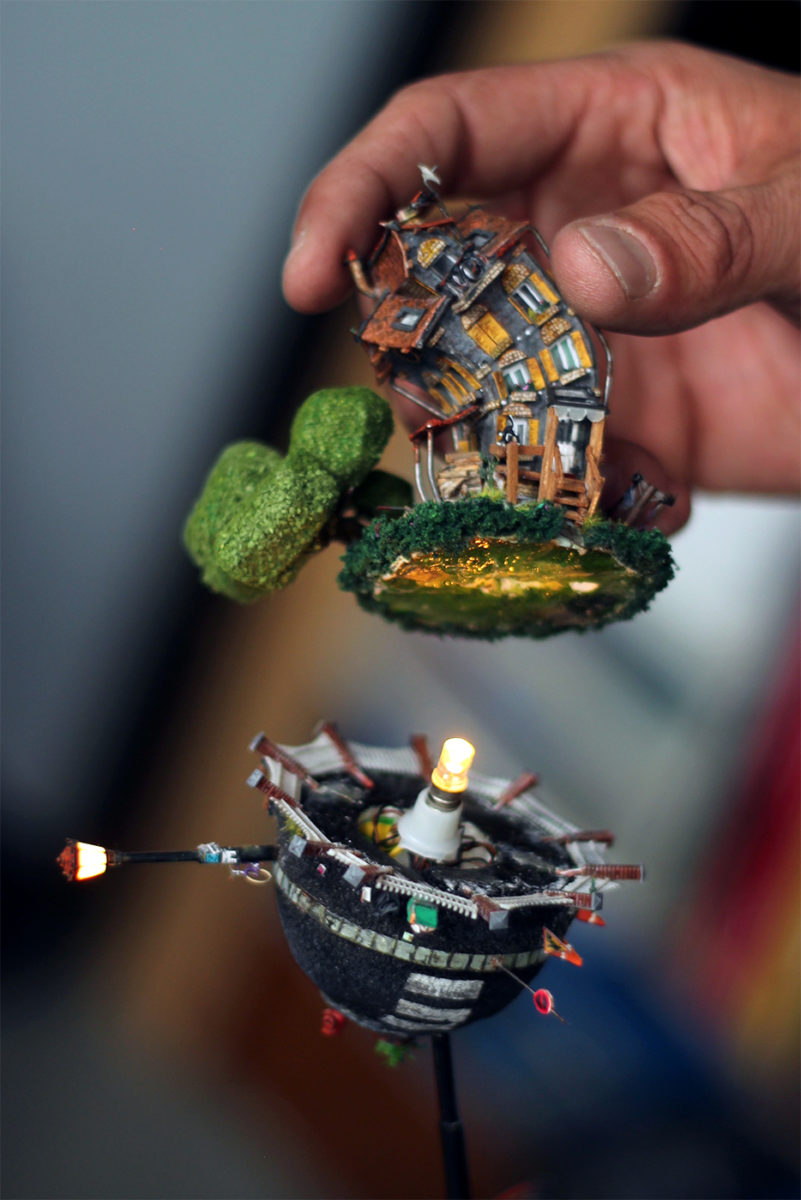
Can you explain how you insert the lights in?
I think the way I insert lights in my models is quite basic. Most of the time it’s just LEDs linked to a transformer. The difficult part is to set the LEDs into very tiny spaces and make it changeable if it have to, manage to hide the electric wire… I plan to learn how to use optical fiber this year and this will allow me to make even tinier things. I sometime integrate little electronic programs to make the lights flicking or other lights effects.
On a big project call Portera Polis I worked on, in addition of a small smoke generator, a little motor, a tiny screen, an electric train and about 30 LEDs, we also integrated a real little river. Put all that cable and connections close to the water reservoir in the core was very tricky. On this project I also had to learn the chimney operating principle. In fact I thought that for crafting a factory I just had to put a small smoking machine for models in a little box with a pvc pipe as chimney. I was wrong, I quickly saw that physics also works for miniature because the smoke stayed stuck in the box and didn’t come out the chimney. I had to learn and understand how it technically works in a real chimney before attempting to make a miniature one working. That was long and tedious personal project but very complete with various techniques and with complex electronic and electric devices. The whole project finally combined in exhibition and an animation clip. Very educational for the future.
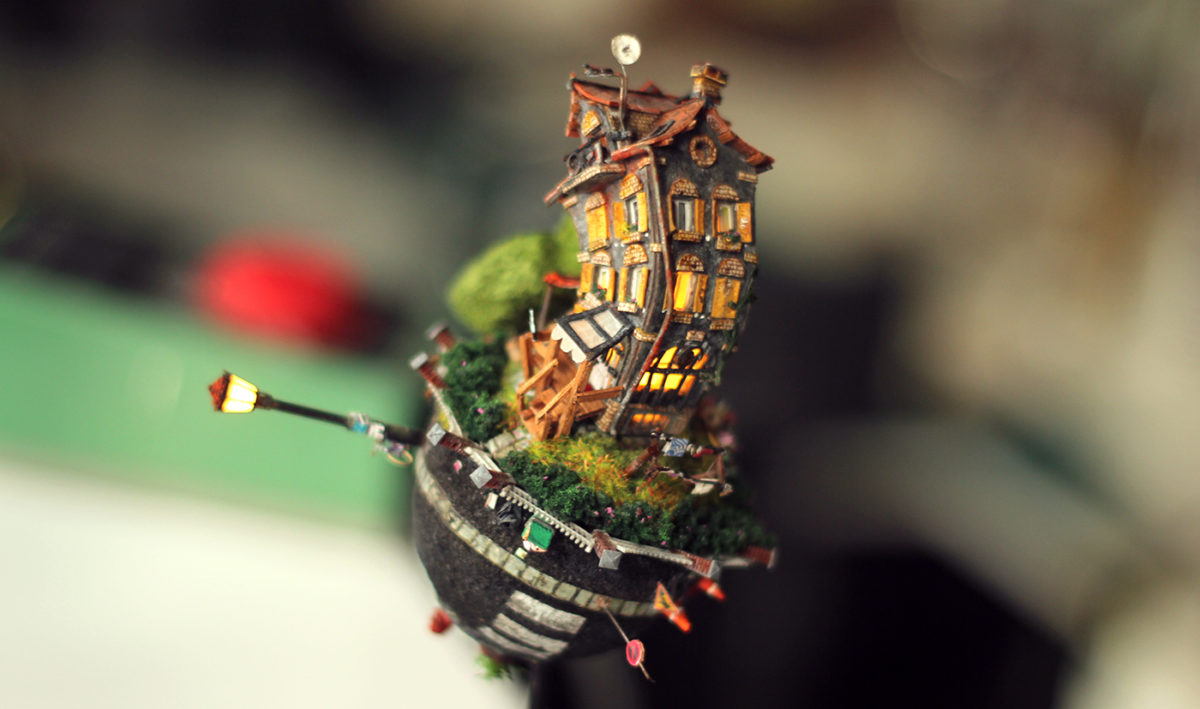
How long did you spend on this planet for example? [see above]
This one took me about five days. It’s on average, the time I spend on that size and kind of planet (5 cm in diameter). Two or three days on a 2,5 cm and I can spend something like a month on a 10 cm one. The big collaboration project I was talking about in the previous answer took almost a whole year to make the model (full time for me, half time for my fellow worker). It was a women’s legs life cast surrounded by a big 30 buildings city. Another little year (3 people half time working) to make a 3 minutes music clip, animated in 2D and stop motion.
I do like big project but I prefer shorter ones. The ideal for a quick project is two week max for the model making, a week for the shooting. The rest of the job is not my part, so I’m not concern about how long it takes, but I like not to wait too long before seeing the animations make my models come alive haha! What a satisfaction to see the final clip knowing that it all started from a piece of cardboard…
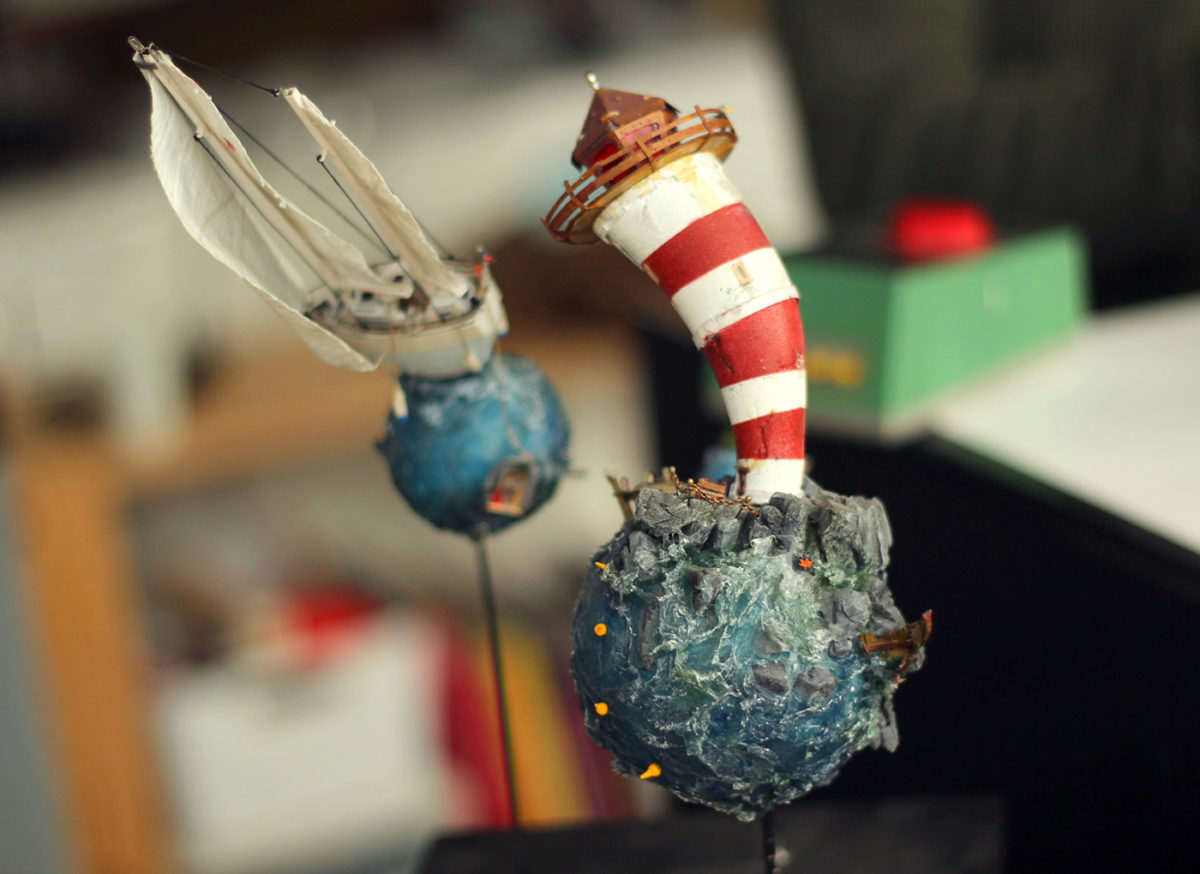
One thing that got me pretty curious is this water texture on your lighthouse and boat compositions. How did you get that amazing render?
Ahah this water texture make every body curious however it’s something a very common material that you can find in every store’s DIY department. And, here’s the second secret recipe haha : it’s bathroom seal silicone to which I add ink and/or some pigments. I then make the waves and the sea foam with a dry brush of white acrylic.
Some years ago, I decided to make an ocean planet sculpture, that mean a small polystyrene ball fully cover of water. When I was talking to diorama creators or diorama materials dealers, I realized that none of them knew a product that wouldn’t be too much liquid to be applied to a sphere without pouring. For the water effect they use resins, things that I couldn’t use : too liquid, too corrosive for polystyrene, and on top of that resin is a material I do not like to use. I needed something more gelled, like hair gel but which could dry keeping the same aspect. And one day, while I was remaking my bathtub joints, I thought : how that material could be abandoned to the DIY stores while it could be such a good tool for crafters and scratch builder like me! Unfortunately it’s static when it dries, so it only works for sculpture, not for an animation set. I haven’t tried yet, but I’m sure making a first layer of coloured silicone then a thin layer of transparent gel like hair gel would work for animated water with stop motion (in addition of making the planet more sexy ahah).
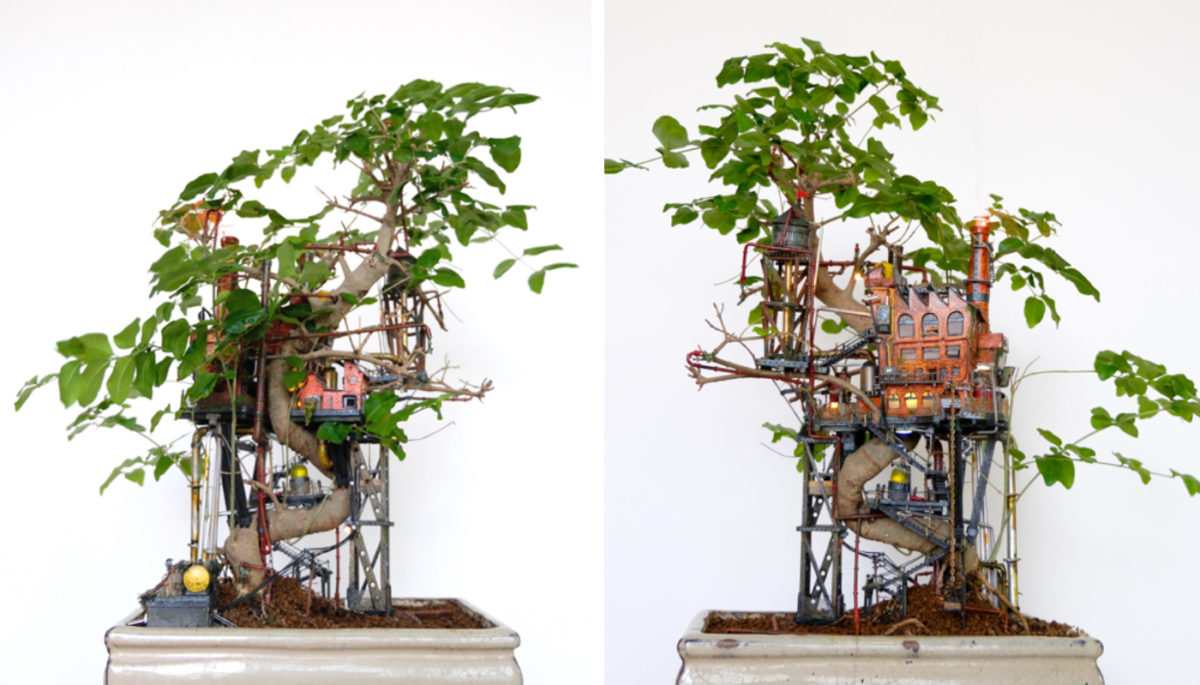
Could you give us some influences/inspiration sources?
My influences and inspirations come from various horizons: Sculptors, miniatures artists, films directors and studios, animators, musical artists, illustrators, cities and landscapes I’ve been to, galaxies and planets I’ll never go, street and hip hop culture in general…
First of all, the movie that marked my childhood the most is Le Roi et l’Oiseau (The King and the Mockingbird) from Grimault. The city, the kingdom of Takicardie, let a lot of marks in my work, this style of accumulation and growing. Grimault didn’t want to make something similar to the Disney’s movies. The style of the animation as much as the subject of the story. This movie is a deep reflection about society model, the opposite of Disney. They wanted to make something new, with more reflexion, for everyone (not only for children) and the abnegation he showed to release the film as wanted it to be, even thirty years later (started in 1953, released in 1980), for all that I admire him.
The studios Laika and Aardman gives me the love of stop motion. Laika for their innovation and artistic direction, Aardman for their traditionalism and their British sense of comedy. Working for one of those two studios would be a dream for me, hope it will come true one day.
Les Lascars is for me a cult French animated series, I am huge fan of this kind of humor, and more over the powerful graphic style of their back grounds certainly contribute to build the style I have today.
Ron Mueck and his hyper realistic sculptures has also influenced me a lot during my « life cast » years. He is probably the artist who let the most unforgettable memories at an art exhibition.
Miniature artists like Joshua Smith for the realism of his building, Damien James Webb for the directness of the colors he uses, Simon Laveuve for his rusty effect and the texturing.
The Lord of loop Victor Haegelin who I had the pleasure to meet and see at work, is very inspiring for the hilariousness and the quality of the clip he makes. His loops are so perfect that you can watch a five second clip loop for an hour! And of course what a better source of inspiration than all the people I am working and living with?
Who’s the person behind the 2D animation in your videos? How did you guys meet?
The guy behind the 2d animation is named Quentin Cordonnier. He is a 2D animator specialized in FX, like fire, explosions, snow… He is known for being the guy behind the magic wind in the movie « Klauss ». We are are cousins and we always did stuff together, we started making animated video in 2012.
So with Quentin and another friend of us, Geoffrey Bagé, with whom we used to edit skateboard videos during our teenager years, thought we missed creating stuffs together. Our reunited skills were beginner film director, 2D animator, and self-taught model maker. We quickly had the idea to create a hybrid style of animation mixing 2D hand draw animation, handmade sets and vehicles, shoot in live or stop motion. Our two first projects together were musical clip and were about Human’s condition in big cities.
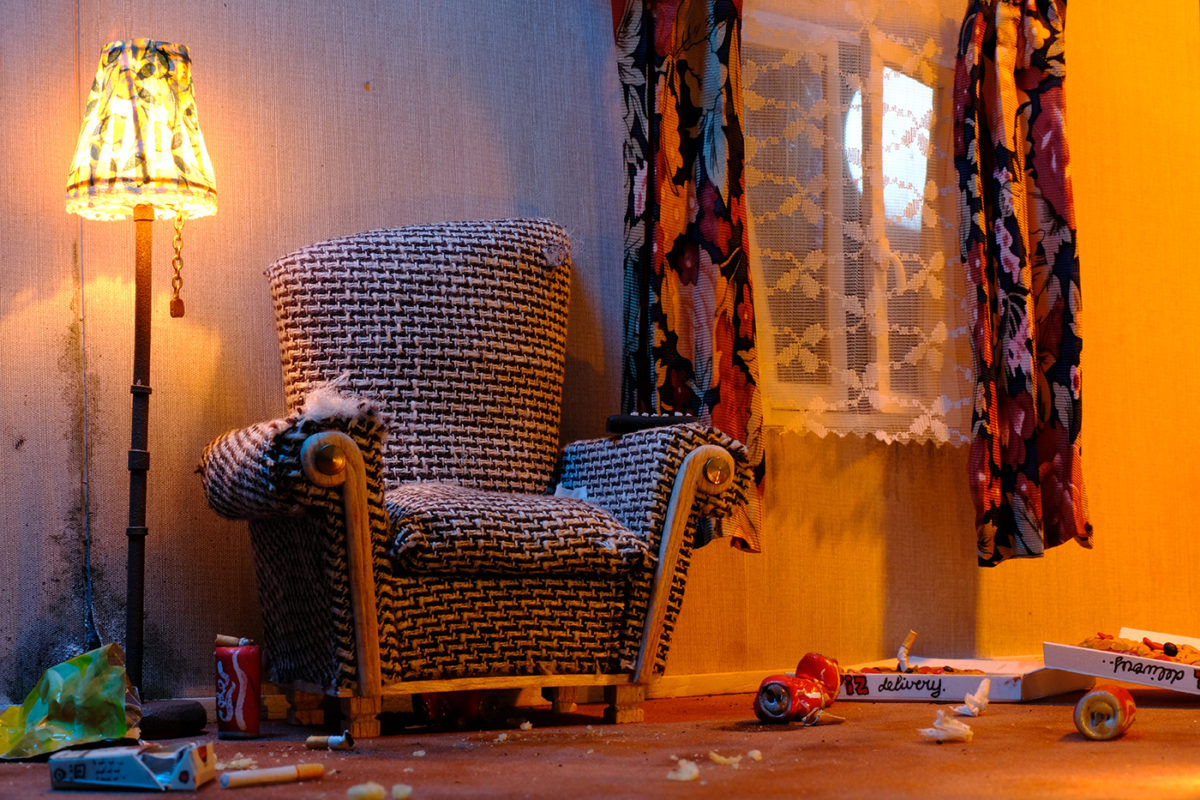
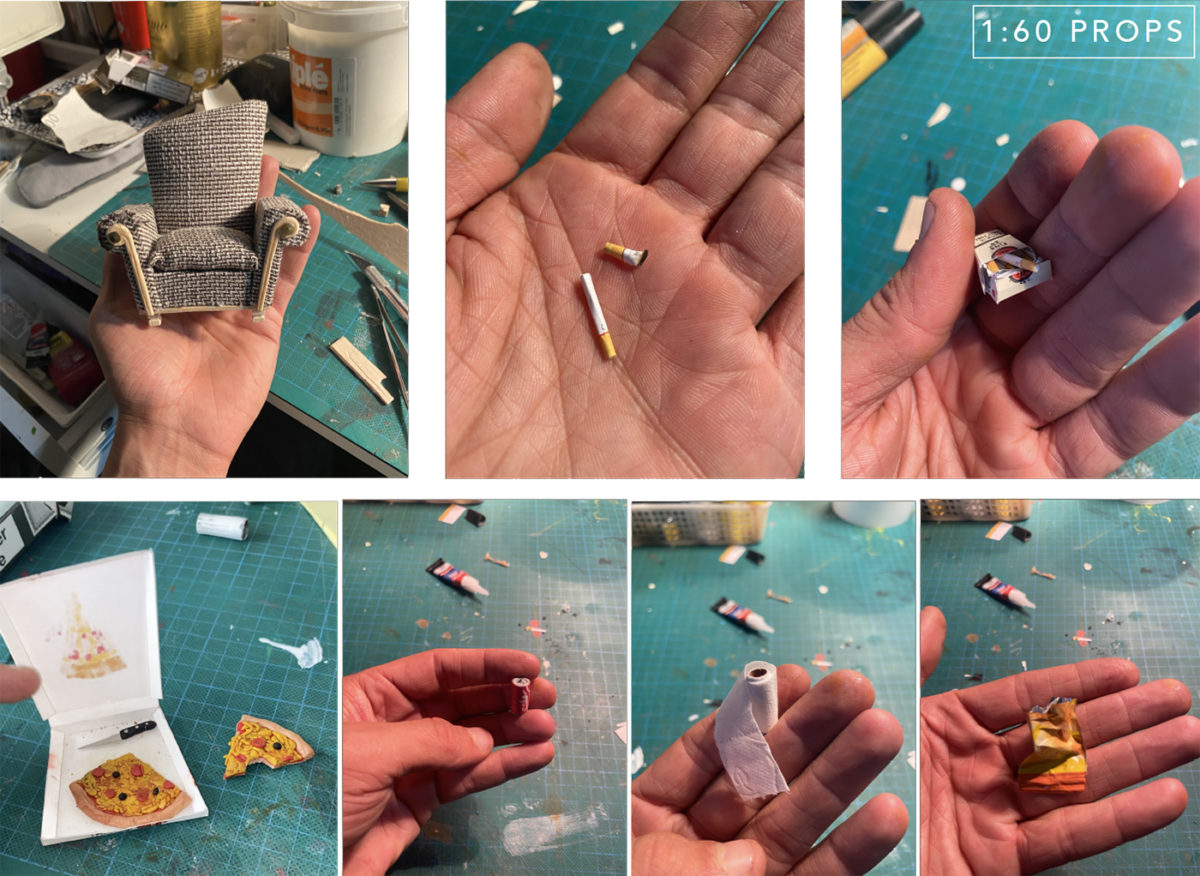
What’s your next big project?
After these two bigs ones, we preferred to make shorter videos more like kind of episodes or just simple loops. The next project will be a short video resulting from a collaboration with severals animators, each one using different style of animation. You may have seen the living room on my instagram, it’s the set we are using for this project. Quentin will naturally add 2D character to it. The others artist will use their own style and we’ll make a savorous cocktail with all that.
After that, we would like to start a big new project with the 22 planets I’ve already done. We’ve got a lot of stories ideas but we haven’t chosen yet the format (short movie, series?). The pitch will certainly be about a cosmic trip above all the planets but you will understand that I prefer not to say too about that much for the moment ;)
And of course, this movie project Quentin and I are currently working on with Frédéric Chignac (film director) and Marine Alaric (Les Films Velvet production). This one is a very big project with a lot of challenges. For the moment we have already finished our first part of the job, included environment/background research with drawings and scale models, characters designs and the story board. The fundraising files will be completed and then will come the production job.
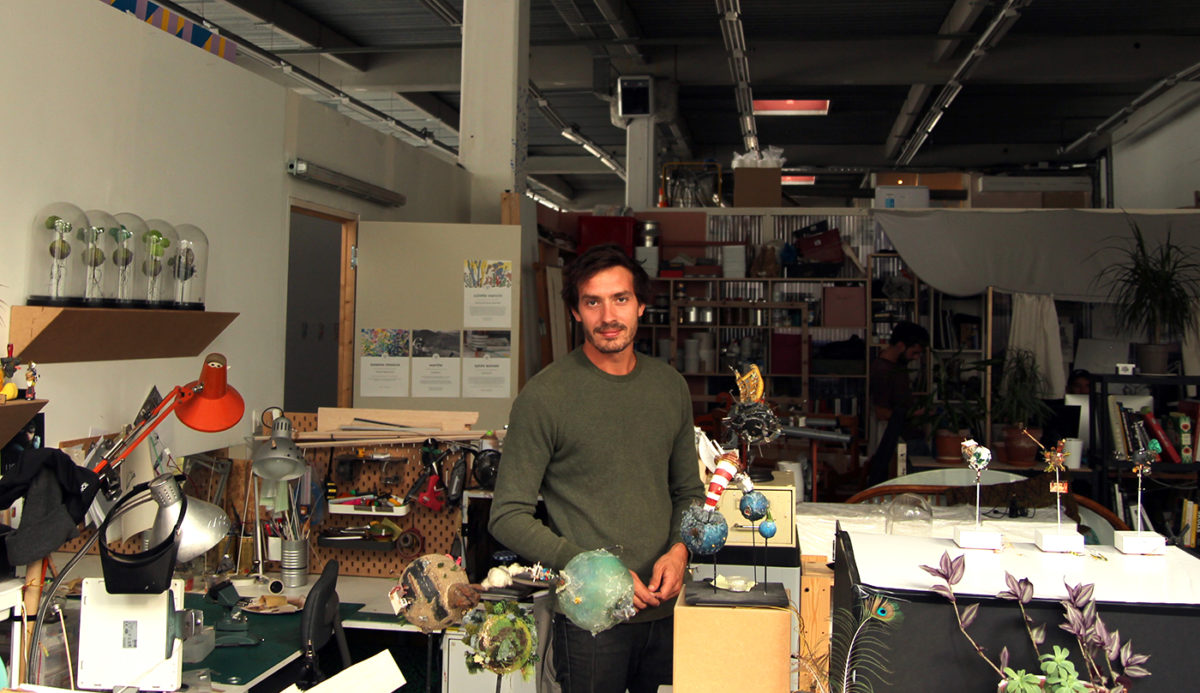
Can you tell us more about your workshop?
It’s been already a year that I integrated the Association OPAZ in Aubervillers, in the east side of Paris. We are an association of something like 50 artists sharing three big work spaces, each one divided in smaller workshops. It’s a real creativity booster because these are all sort of trades like illustrators, painters, sculptors, wood workers, visual artists, weavers, upholsterers, photographers, musicians, paper artists, landscape architects, even a truck food and many others. We all try to involve ourselves as much as we can for the good working of the association and it seems to be working quite well. On December 5th we will open our doors to the public for an exhibition and we certainly will in April too, come to see us!
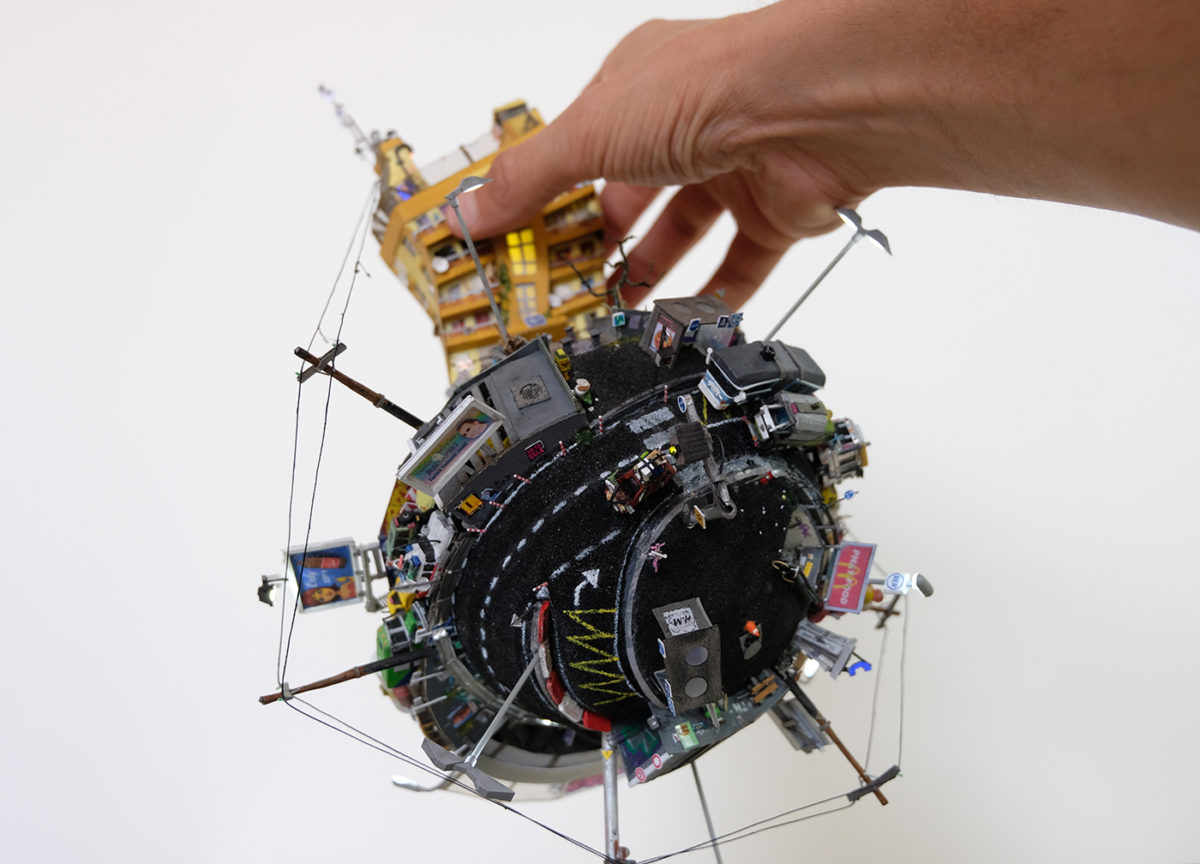
Which one of your planets is your favorite and why?
Even if you don’t ask a parent who is his favorite child, I think the biggest one is my favorite one. Called « Da Bloc Ball » it represents a building and its whole block on a 15 cm in diameter planet. I like this one because there is so much details to look at, so much sceneries to imagine on it. I also had a lot of fun making something like 40, 1:200 scale miniature cars, some of them are iconic cars from movies. I love to nod movies, other artists or stupid stuffs in my models and these are a lot in this one. You can also have a look into most of the windows, and even if they are 5 mm large, you can see things in theses, like someone pooping, some others having fun naked. A murder just happens in another window, the neighbours below look to be squatters… I also reproduced the window of the DJ Cut Killer in the famous scene from the movie « La Haine » by Mathieu Kassovitz. The only people you can see are the three ones through the windows but it seems very full of life. We could make a 20 episodes animated series on « Da Bloc Ball ».
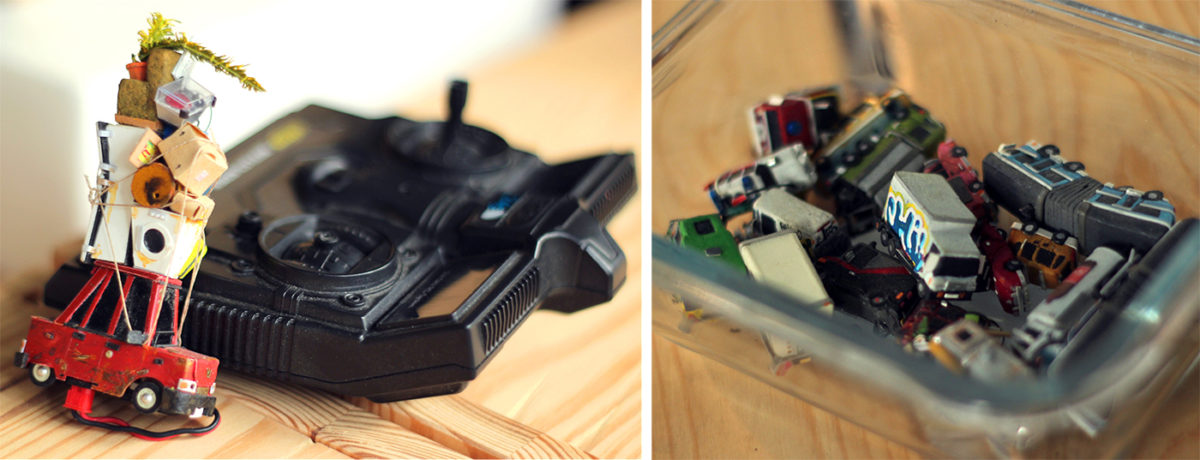
You recently let go of your pastry cook job to dive full time into model making. How do you feel about it?
Except the fact that money does not come as much easy as in hotels and restaurants industry, I feel very good and liberate about it. For me, for the moment it’s just a detail because I think I spent to much time working in a job that didn’t suit me and my values. Maybe it’s the fact that I only worked for the luxury industry during my pastry years that made me a little bit disgusted about this job.
Even more than the arduousness of the job, it’s the loving model making that pushes me to my professional retraining. You know pastry is also a complete artistic work, but I didn’t manage to express myself as much when I‘m making cakes (even in the pastry laboratories with the biggest budget in Paris) as I do in model making. I also wanted to create art that doesn’t disappear in a few spoonfuls, something less ephemeral. And one day, tired of hearing everyone I’ve showed my art work to, asking : « but why the hell are you not living of you art ?», I took that decision, I know it’s gonna be a long and difficult path, but with patience and passion it should work!
Thanks a lot Tristan and good luck!
